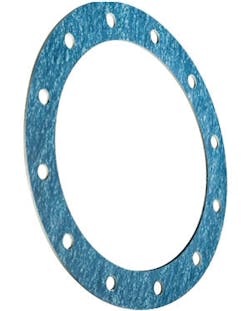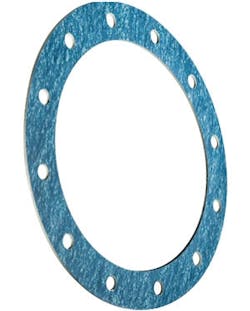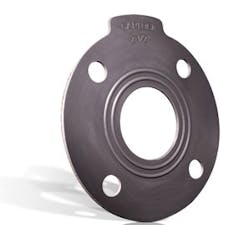By Matt Tones
Growing global concern about water conservation, together with the large number of water infrastructure projects currently active in the U.S., warrants a better understanding of the dynamics of bolted flange assemblies. This includes the advantages and disadvantages of AWWA C207-07 flanges, bolting, and the gasketing materials used in these connections.
Because they are designed for use under lower pressures, AWWA C207 flanges are thinner than ASME/ANSI flanges even though they have the same drilling dimensions. As a result they tend to bend more easily at higher torque values, adversely affecting gasket compression and load. Moreover the most commonly recommended bolt grade for Class B (86 psi) and Class D (175 psi) flanges is ASTM A307 B, a low-carbon-steel, low-strength bolt with a yield strength of approximately 36,000 psi. Its relatively low allowable torque means lower compressive load on the gasket.
For higher pressure Class E (275 psi) and Class F (300 psi) flanges the C207 specification calls for high-strength ASTM A193 B7 bolts. These bolts provide higher stress to compensate for hydrostatic end forces at higher system pressures. They also provide more compressive force to properly seal gaskets designed for higher operating pressures.
A recent addition to C207 specification is the recommendation for bolts made of "equivalent strength stainless steel materials" for buried or submerged piping systems. Stainless bolts of equivalent strength to A307 Grade B are readily available; ASTM A193 B8 Class 1, one of the most common grades of stainless bolts, provides a yield strength of 30,000 psi, comparable to that of A307 Grade B (36,000 psi).
Finding higher strength bolts (equivalent to A193 B7) for Class E and F flanges can be a bit of a challenge.
ASTM A193 B8 Class 2 strain-hardened stainless bolts are available through 3⁄4". However as the bolt size increases, yield strength begins to decrease (80,000 psi for 7⁄8" through 1"; 65,000 psi for 11⁄8" through 1¼"; 50,000 psi for 13⁄8 to 1½"). This directly impacts larger flanges where the yield strength of A193 B8 Class 2 bolts is 50% less than that of A193 B7 carbon steel bolts.
Gasket selection
Too often the gasket is the last thing to be considered when designing or assembling a flanged connection. Ideally the gasket should govern the design of the flange in which it will be installed, a concept that gave rise to "m" and "y" factors or new Gasket Constants (Gb, Ga, Gs) used in the design of custom flanges.
Prior to the 1990s one of the most commonly used gasketing materials for flanged connections was cloth-insert rubber, a lower grade styrene butadiene rubber (SBR) with one or more reinforcement layers of woven cotton, nylon or other textiles. This type of material had better crush resistance than homogeneous rubber, but would wick water to the outside of the pipe, resulting in "nuisance" leaks.
By the mid-1980s this leakage had prompted many utilities to replace cloth insert with homogeneous SBR gaskets, while compressed asbestos gasketing was being replaced by non-asbestos materials in higher pressure Class E and F flanges. The homogeneous rubber gaskets were designed to seal with low assembly stress (600 psi-1,200 psi) and operate at lower pressures (<150 psig). Non-asbestos compressed fiber gaskets were developed to seal with higher assembly stresses (4,800 psi-15,000 psi) and to operate at system pressures up to 275 psig.
The nuisance leaks of the past have become unacceptable in this era of environmentalism and resource conservation. Since flange design has remained essentially unchanged over the years, the onus of stopping these leaks has fallen on the developers of gasketing. A new generation of gaskets for municipal water systems are easier to use, seal better and last longer than their predecessors. In addition they can withstand exposure to new water treatment chemicals such as chloramines.
For rubber or elastomeric gaskets, that means improved chemical and ultraviolet (UV) resistance, as well as enhanced physical properties such as compression set. Many utilities have begun using ethylene propylene diene monomer (EPDM) gaskets for these reasons. In addition to the type of elastomer used, the gasket selection process must take into account formulation and processing which affect properties such as durometer (hardness) and compression set (load retention).
Technology advances
Since the introduction of non-asbestos compressed sheet gaskets in 1980, there have been significant advances in fiber technology and processing techniques, the most notable of which is controlled swell technology. Sheets of material designed to swell in oil have been used for many years in the automotive and heavy equipment industries. The swelling action allows the material to create a small amount of load, which counteracts the effects of gasket creep, or load loss, and other external variables such as thermal cycling, vibration and other structural movements.
Among the most recent advances in sealing for AWWA systems are controlled-swell gaskets (Figure 1), which develop their own load in the presence of water, and PTFE gaskets (Figure 2) that are NSF/ANSI 61 approved for use in potable water systems.
A gasketing material has been developed recently that swells in both oil and water, allowing it to create load in flanged connections. Conventional compressed sheet gaskets tend to "relax" and eventually leak, whereas controlled swell gaskets produce enough additional compressive force to prevent leaks. Controlled swell gaskets also provide a solution to the conundrum posed by the inverse relationship between the size and yield strength of stainless steel bolts. Even A193 B8 Class 2 bolts may not be able to apply sufficient stress to effectively seal larger flanges, yet the use of higher strength carbon steel bolts may not be feasible due to corrosion concerns. In these instances the self-loading action of controlled swell gaskets can provide long-term, leak-free service.
Key to ensuring long-lasting flanged connections is understanding their constituent components and how they interact with one another. In many cases this may involve weighing component costs against desired performance. While the best available technology may be more expensive at the outset, it will invariably more than pay for itself in terms of more reliable performance, reduced maintenance and, perhaps most important, better conservation of a valuable natural resource. WW
About the Author:Matt Tones is senior manager of applications and engineering services for Garlock Sealing Technologies. He has more than 10 years of experience in applications engineering, and has also served as product manager for the company's line of PTFE gasketing, as well as an OEM sales correspondent and laboratory technician. He may be contacted at [email protected].
More WaterWorld Current Issue Articles
More WaterWorld Archives Issue Articles





